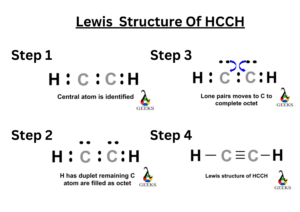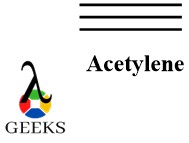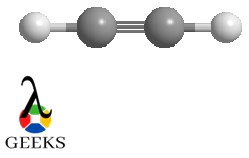Ethyne (HCCH), commonly known as acetylene, has a linear structure with a carbon-carbon triple bond. Each carbon (C) atom, with 4 valence electrons, is bonded to one hydrogen (H) atom and triple-bonded to the other C atom. The Lewis structure shows two C atoms connected by a triple bond and each C atom bonded to an H atom. This arrangement uses 10 valence electrons: 2 for each C-H bond and 6 for the C≡C bond. The molecule is linear with a bond angle of 180°. The high electronegativity of carbon (2.55) and the triple bond contribute to its reactivity, especially in combustion and polymerization reactions.
HCCH lewis structure is a hydrocarbon of class alkyne which in itself means the presence of triple covalent bonds between the carbon atoms involved. HCCH lewis structure is the first hydrocarbon of the alkyne class. It can be denoted as C2H2, acetylene, or ethyne according to the nomenclature. It is a colorless gas with no odor and is highly unstable due to its high degree of unsaturation. It readily converts into ethene which in turn gets converted into ethane to achieve stability.

HCCH lewis structure was first discovered in the year 1836 by the reaction of K2C2 with water which released the acetylene gas. Another scientist named Berthelot synthesized the HCCH lewis structure by passing hydrogen through the carbon arc. Apart from these historical methods the most commonly used synthetic methods in the present scenario are partial combustion of methane, usage of Ziegler-natta and Pd-Ag catalysts, etc.
HCCH lewis structure is an important compound in organic chemistry and is used in various named organic synthetic methodologies. Some of the most popular named organic reactions of HCCH lewis structure are vinylation reaction, Ethynylation reaction, carbonylation reaction, organometallic chemistry, and acid-base reactions. HCCH lewis structure has many industrial applications in welding, electronic industry, and plastic industry.
The physical, structural and electronic properties associated with HCCH lewis structure are discussed ahead:

- How to draw HCCH lewis structure?
- HCCH lewis structure resonance
- HCCH lewis structure shape
- HCCH lewis structure formal charge
- HCCH lewis structure angle
- HCCH lewis structure lone pair
- HCCH lewis structure octet rule
- HCCH lewis structure valence electron
- HCCH lewis structure hybridization
- HCCH lewis structure solubility
- Is HCCH lewis structure soluble in water?
- Is HCCH lewis structure an electrolyte?
- Is HCCH lewis structure a strong electrolyte?
- Is HCCH lewis structure acidic or basic?
- Is HCCH lewis structure a strong acid?
- Is HCCH lewis structure a polyprotic acid?
- Is HCCH lewis structure a lewis acid?
- Is HCCH lewis structure an Arrhenius acid?
- Is HCCH lewis structure polar or nonpolar?
- Is HCCH lewis structure linear?
- Is HCCH lewis structure paramagnetic or diamagnetic?
- HCCH lewis structure boiling point
- Is HCCH lewis structure ionic or covalent?
- HCCH lewis structure hydrogen bonding
How to draw HCCH lewis structure?
For drawing HCCH lewis structure certain steps are involved which are explained below:

Step 1: Count the total number of valence electrons
HCCH lewis structure involves 2 atoms namely carbon and hydrogen. Carbon has 4 valence electrons and hydrogen has 1 valence electron. So according to HCCH lewis structure formula C2H2 there are a total 4×2 + 2×1 = 10 valence electrons.
Step 2: Finding the central atom
It is known that while drawing the lewis structure the central atom is one with the least electronegativity. Here there are only 2 atoms: carbon and hydrogen are involved. Hydrogen is the least electronegative element in the HCCH lewis structure and should be the central atom according to the convention, but because of its small size, it cannot hold the position. So both the carbon atoms in HCCH lewis structure should be the central atom.
Step 3: Bonding between the atoms and the octet completion
HCCH lewis structure is a symmetrical organic structure. Now to complete its octet stability both the carbon atoms need to gain 4 more electrons each and both the hydrogen atoms need to gain 1 electron each. So there will be sharing of electrons between the atoms in the HCCH lewis structure. One carbon atom will share its one electron with the hydrogen atom forming a single covalent bond and the rest of the three electrons with the other carbon atom forming a triple covalent bond.
Step 4: Calculating the formal charge of HCCH lewis structure
The formal charge calculation of every atom involved in the HCCH lewis structure will prove its authenticity and confirm its existence. Here the formal charge of both H and C is 0 in the HCCH lewis structure thereby confirming the reliability of the HCCH lewis structure.
HCCH lewis structure resonance
HCCH lewis structure does not exhibit the resonance phenomena. Though its other counterparts could exhibit the same. The reason behind this is the presence of hydrogen atoms on both sides. As hydrogen is a duplet, delocalization of electrons and the movement of bonds is not possible because it will disturb the stability of the structure.
Hence HCCH lewis structure does not have any resonating or canonical structure and only 1 structure can explain all the properties associated with it.
HCCH lewis structure shape
HCCH lewis structure is a symmetrical molecule which is evident from its lewis structure formation. Being symmetrical means that the elements on the left side are the same on the right side.
Another thing it signifies is that all atoms involved in the HCCH lewis structure are in the same plane. So this symmetrical nature and being in one plane means that the HCCH lewis structure is linear in its shape and molecular geometry.

HCCH lewis structure formal charge
Formal charge calculation is an indicator to confirm the identity of the molecule. It is estimated that the lower the formal charge the more reliable and authentic the lewis structure is. The formula for calculating formal charge is
Formal Charge = Valence electron – unbonded electrons – 1/2bonded electrons
FC for hydrogen atom in HCCH lewis structure = 1 – 0 – 2/2 = 0
FC for carbon atom in HCCH lewis structure = 4 – 0 – 8/2 = 0
HCCH lewis structure angle
As already mentioned above HCCH lewis structure has linear geometry because of its symmetrical nature and presence of all the atoms in the same plane.
Also in the HCCH lewis structure both the carbon atoms form a single covalent bond with the hydrogen atom. So the bond angle in the HCCH lewis structure is 180 degrees.
HCCH lewis structure lone pair
Lone pairs are the electrons that are left behind during chemical bond formation. They are also valence electrons but they do not participate in chemical bonding.
As far as HCCH lewis structure is concerned there are no lone pairs of electrons as all the valence electrons have participated in the bonding. So in the HCCH lewis structure, there are only bond pairs and no lone pairs.
HCCH lewis structure octet rule
The octet rule is the stability criteria followed by the main group elements of the periodic table where after chemical bond formation every element involved in the compound should have 8 electrons in their valence shell.
In HCCH lewis structure as the formula suggests the arrangement of atoms is symmetrical and both the sides follow the same type of bonding. It is evident that carbon belongs to group 14 and hydrogen belongs to group 1 of the periodic table. They have 4 and 1 valence electrons and need 4 and 1 more respectively to complete their octet stability.
So being non-metals there will be sharing of electrons where the 4 electrons of carbon will share their 1 electron with hydrogen and the other three electrons with adjacent carbon atoms forming a C-H single covalent bond and triple covalent bond between the carbon atoms. This will fulfill the criteria of the octet rule in the HCCH lewis structure.
HCCH lewis structure valence electrons
Valence electrons are the most important electrons in the HCCH lewis structure. Because of their long distance from the nucleus are easily able to share electrons for chemical bond formation. In HCCH lewis structure before the sharing of electrons, there were 4 valence electrons in the carbon atom and 1 valence electron in the hydrogen atom.
This makes a total of 10 valence electrons as 2 carbon and 2 hydrogen atoms are involved. After the sharing of electrons, there are 8 valence electrons in both the atoms involved to maintain the octet stability criteria.
HCCH lewis structure hybridization
For understanding the hybridization of HCCH lewis structure it is important to understand the electronic configuration of atoms involved. The electronic configuration of carbon in its ground state is 1s2 2s2 2p2 but in the excited state while sharing electrons the electron moves from the 2s orbital to the 2pz orbital which overlaps with the 1s electron of hydrogen.
As there is one s and one p orbital involved in HCCH lewis structure hence hybridization of HCCH lewis structure is sp.
HCCH lewis structure solubility
HCCH lewis structure is soluble in both polar and nonpolar solvents but it shows different behavior as it is an organic compound. Apart from that HCCH lewis structure is soluble in several solvent mixtures.
In terms of pure solvents, HCCH lewis structure is soluble in hexane, cyclohexane, hexadecane, hexadecane, benzene, methanol, butanol, water, ethylene glycol, etc. In terms of mixtures, the HCCH lewis structure is soluble in butanol-ethylene glycol, and hexane-hexadecane at atmospheric pressure and a temperature range from 0 degrees Celsius to 50 degrees Celsius.
Is HCCH lewis structure soluble in water?
The solubility of HCCH lewis structure in water is a very controversial question. Some schools say that it is not soluble in water because water has very strong hydrogen bonding and it is very tough for HCCH lewis structure to break it.
Another school of thought says that the HCCH lewis structure is partially soluble in water and releases toxic ammoniacal fumes.
Is HCCH lewis structure an electrolyte?
No, HCCH lewis structure is not an electrolyte. For being an electrolyte the compound should be able to dissolve in an aqueous medium and able to dissociate with its constituent ions. But HCCH lewis structure does not fulfill any of the above criteria, hence it is not an electrolyte.
Is HCCH lewis structure a strong electrolyte?
HCCH lewis structure is not considered an electrolyte. It is not present in any other categories of potential electrolytes. The reason for the same is that the HCCH lewis structure is an organic compound with a strong carbon-carbon triple covalent bond.
So it cannot be dissociated into ions in an aqueous medium which is expected from the electrolytes. Also, it is not soluble in water so its aqueous form cannot be created.
Is HCCH lewis structure acidic or basic?
HCCH lewis structure or acetylene is acidic. This is because the sigma electron density of C-H is nearer to carbon which has 50% s character according to the sp hybridization of HCCH lewis structure.
. Because of the presence of two acidic hydrogens in the HCCH lewis structure, the more electronegative carbon tries to gain electron pair between C-H bonding which leads to dissociation and release of proton thereby imparting acidic character to the HCCH lewis structure.
Is HCCH lewis structure a strong acid?
No, the HCCH lewis structure is not a strong acid. It is considered a relatively weak acid as compared to its other acidic counterparts. This is because the extent of dissociation in HCCH lewis structure is relatively low.
This is because the HCCH lewis structure has sp hybridization that causes the activation energy barrier for the dissociation equation to be high which stops the reaction to move in the forward direction completely. Hence HCCH lewis structure is acidic but a weak acid.
Is HCCH lewis structure a polyprotic acid?
Polyprotic acids are those acids that can give more protons per reaction when reacted with water. As far as HCCH lewis structure is concerned then it is not a polyprotic acid as it is a weak acid and its dissociation is not completely in the forward direction.
Also, the reaction of HCCH lewis structure with water happens in the presence of sulphuric acid and gives an unstable product that converts to aldehyde. This is an example of an organic nucleophilic addition reaction. Hence HCCH lewis structure cannot be considered polyprotic acid.
Is HCCH lewis structure a lewis acid?
No, HCCH lewis structure is not lewis acid. Instead, it is a lewis base. A lewis base is a compound or ion which can donate a pair of electrons to the acceptor compound. Lewis bases are usually electron-rich species.
Precisely any compound which has a lone pair of electrons or extra bonds can act as a perfect lewis base. As far as HCCH lewis structure is concerned then it fulfills the criteria as it is electron-rich and has 2 pi bonds.
Is HCCH lewis structure an Arrhenius acid?
Yes, HCCH lewis acid is an Arrhenius acid. The Arrhenius concept is based on the dissociation of the acid and the release of proton or hydronium ion. HCCH lewis structure is a weak acid because it dissociates partially due to high activation energy. So HCCH lewis structure is an Arrhenius acid but with weak dissociation.
Is HCCH lewis structure polar or nonpolar?
HCCH lewis structure is non-polar because of electronegativity difference which is less than 0.35. For a compound to be polar it should have an electronegativity difference of 0.4 or more.
Another reason is its shape. HCCH lewis structure is a linear structure and its C-H bonds are nonpolar which implies a net-zero dipole moment.
Is HCCH lewis structure linear?
Yes, the HCCH lewis structure is linear in its shape and molecular geometry. This is because the HCCH lewis structure is symmetrical and all atoms lie in the same plane. Also, its hybridization is sp. So all these factors point to the HCCH lewis structure is linear.
Is HCCH lewis structure paramagnetic or diamagnetic?
HCCH lewis structure is diamagnetic. According to the NMR studies, there is no paramagnetic shielding around its symmetry axis. But there is a strong diamagnetic shielding around its symmetry axis due to spatially degenerate pi orbitals.
HCCH lewis structure boiling point
The boiling point of the HCCH lewis structure is -84 degrees celsius. At the atmospheric pressure, the HCCH lewis structure cannot exist in liquid form and is unstable. At its triple point which lies in the same region as its melting point, it exists in its liquid state.
. Below this temperature range HCCH lewis structure shows sublimation and directly converts to gas. That point is at -84 degrees celsius which is considered as HCCH lewis structure boiling point.
Is HCCH lewis structure ionic or covalent?
HCCH lewis structure by all means is a covalent compound. It is very well known from the structure that there are no metals involved and the lewis structure formation is because of the sharing of electrons where there is a C-C triple bond.
Also, the electronegativity difference between the elements carbon and hydrogen is not much pronounced to shift the electron cloud to one side only. Hence HCCH lewis structure shows complete covalency.
HCCH lewis structure hydrogen bonding
Hydrogen bonding is not possible in the HCCH lewis structure. It is not even possible in any hydrocarbon. In hydrogen bonding, there should be at least one O-H, F-H, and N-H bond which means one hydrogen atom should be attached or directly bonded to an electronegative atom.
. As far as HCCH lewis structure is concerned then all hydrogen atoms are bonded to the carbon atoms and the C-H bonding is not that much electronegative to be considered as hydrogen bonding.
Conclusion
In a nutshell HCCH, lewis structure is an important hydrocarbon and belongs to the alkyne class of organic chemistry. Due to the presence of a triple bond between the carbon atoms, there are variations in its properties. These variations are observed in its shape, electronegativity, bond energy, and other physical, chemical, and electronic properties associated with it.
Also Read:
- N2o2 lewis structure
- Nh2cooh lewis structure
- Ncl4 lewis structure
- Pf2cl3 lewis structure
- Na3po4 lewis structure
- Na2o lewis structure
- Nsf lewis structure
- Ccl4 lewis structure
- Nano3 lewis structure
- H2o lewis structure

Hello, I am Mansi Sharma, I have completed my master’s in Chemistry. I personally believe that learning is more enthusiastic when learnt with creativity. I am a Subject Matter Expert in Chemistry.
Let’s connect through LinkedIn: https://www.linkedin.com/in/mansi-sharma22